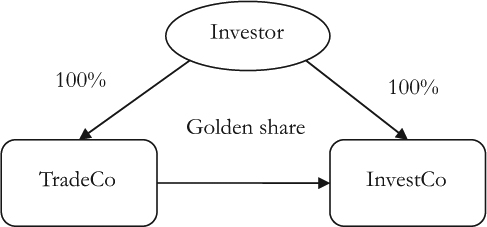Holding Assets Tax Efficiently
Introduction
The tax position of an investor can vary significantly depending on the particular way in which assets are held. The differential between the rates of; income tax, corporation tax and capital gains tax (CGT) means that the choice of vehicle to hold the asset is important. There are also a number of tax reliefs, such as the participation exemption that may influence the vehicle chosen to make the investment.
Common Ways of Holding Assets
The most common alternatives given to an individual seeking to make an investment is to either hold the asset in their own name or to hold it via a company that they control. Although it is less common, it may also be worth considering utilising a trust, investment undertaking or a partnership to hold assets. For a very limited number of individuals offshore structures may be appropriate; it is really dependent on the individual's personal circumstances.
Hold Personality or Via a Company - The Main Tax Considerations
General
An individual who holds an asset personally will likely be subject to CGT at the new rate of 30% (effective for disposals made after 6 December 2011) on any capital gains made on a disposal (assuming the investment is not a fund of some form). Any income generated by the investment would be subject to income tax at the individual's marginal rate of tax (circa 50% in most cases). Similarly a company will be subject to corporation tax on chargeable gains at a rate of 30%, any income generated by the investment is likely to be subject to corporation tax at 25% plus the close company surcharge on any undistributed after tax income.
The Double Charge to Tax
The main tax drawback associated with holding assets via a company is the double charge to tax on the sale of an asset and extraction of cash from the company. This is best illustrated by way of an example.
Example
Martin wishes to acquire an asset, the purchase price of the asset is €500,000 and he expects to sell the asset for €1,000,000 in due course. If Martin holds the asset personally his tax position will be as follows on a sale:
€ |
|
Proceeds |
1,000,000 |
Less: cost |
500,000 |
Gain |
500,000 |
CGT @ 30% (ignore annual exemption) |
150,000 |
Net proceeds available after tax |
850,000 |
Now assume that Martin decides to incorporate a company to acquire the asset; he provides the purchase monies to the company by way of a subscription for share capital. The tax position of the company on sale is as follows:
€ |
|
Proceeds |
1,000,000 |
Less: cost |
500,000 |
Gain |
500,000 |
CT @ 30% |
150,000 |
Net proceeds available after tax |
850,000 |
Assuming that the company will be liquidated, Martin's tax position on liquidation would be as follows:
€ |
|
Proceeds |
850,000 |
Less: subscription for share capital |
500,000 |
Gain |
350,000 |
CGT @ 30% (ignore annual exemption) |
105,000 |
Net proceeds available after tax |
745,000 |
It can be taken from this that Martin would have been €105,000 better off by investing personally rather than via a company. However, it cannot be assumed that holding assets personally is always the best way forward. The following are among the many factors also to be considered:
Availability of Reliefs
Where there are reliefs available from tax these should be factored into the decision making process. For example, participation exemption relief may allow a parent company realise gains on certain shareholdings free from corporation tax on chargeable gains. Also, where the return on investment is to be made by way of dividend payments from an Irish close company, it may be possible (subject to appropriate elections being made) for such dividends to be received by a company free from tax completely. Both of these reliefs are not available to individuals.
Capital Losses
Where an individual has unrestricted capital losses or holds a company with capital losses, it may be worth structuring the investment in a manner such that the losses can be used to shelter any gain arising. It is not possible to transfer the capital losses of an individual to a company or vice versa.
Financing the Investment
One of the most important aspects of the decision making process is how the finance for the investment is to be provided. Where the investor is required to drawdown bank debt or draw funds from their personal trading company some income tax cost may be associated with either the financing of the debt or the cash extraction from the personal trading company (i.e. the investor may have to increase their salary of take a dividend). Broadly, to extract €1,000,000 from a company could cost an investor the same again in income tax.
To avoid the need to draw funds from the personal company it may be possible to incorporate a new investment company which would in turn drawdown the bank debt or take a loan from the personal trading company. It may be necessary to put in place a “Golden Share” type arrangement to avoid a breach of company law by the making of connected party loans.

Partnerships, Trusts and Investment Undertakings
It is possible on occasion for an investor to achieve a more tax efficient structure by holding assets in partnerships, trusts and certain investment undertakings. These structures are particularly useful where there are long term succession plans in place or where the individual is considering making very substantial investments. The tax issues involved are quite complex and the day to day operation of the structures is not as straightforward as personal ownership or ownership via a company.
Offshore Structures
In the vast majority of cases offshore structures are to be avoided. Typically these structures involve the set-up of a company or trust in a tax haven such as the Isle of Man or the Channel Islands. There is a raft of tax anti-avoidance legislation which seeks to remove any Irish tax benefits that would be associated with an offshore structure. For example, gains realised by an offshore company will be attributed to and taxed on its Irish resident members under section 590 TCA 1997. The maintenance of offshore structures is complex and oftentimes very costly. Typically, such structures are only considered by non-Irish domiciled individuals.
Conclusion
There are a number of tax and commercial factors to consider when structuring an investment. As illustrated in the example above significant tax costs can arise where the investment is poorly planned. Non tax factors should also be considered, for example, it may be prudent to make certain investments via a limited liability company if there is an element of risk to the investment. This can be particularly relevant where a large amount of debt is to be taken out.
Mark Doyle is Tax Director with Grant Thornton Financial and Taxation Consultants Limited.
Email: Mark.Doyle@ie.gt.com

